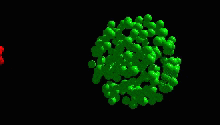New Element 115 May Finally Be Added to the Periodic Table
The International Union of Pure and Applied Chemistry will make the final call of whether or not the time has arrived to confirm ununpentium’s existence
/https://tf-cmsv2-smithsonianmag-media.s3.amazonaws.com/filer/20130828124026un.jpg)
A new element may soon join the periodic table: an international team of researchers announced this week that they have confirmed the existence of Ununpentium, elusive element 115. Although the element was first reported in 2004, researchers have had trouble getting it to stick around long enough to prove its existence.
Part of the difficulty of discovering these high-numbered elements is that, rather than finding them buried in a meteorite or deep in the ocean floor, researchers have to create the elements themselves. Popular Science explains the process:
Why do we say that people “synthesized” or “made” ununpentium, instead of saying people “found” it? Well, like other super-heavy elements, ununpentium can only exist when people perform experiments to create it. It’s an entirely synthetic element (ununpentium : elements :: polyester : fabrics?). You can’t just cook it up in any lab, either. The creation of elements heavier than uranium, which is the heaviest element to occur naturally on Earth and contains 92 protons, requires fusion reactions, nuclear reactions, or other highly specialized chemistry.
Here’s what that looks like, in a model, shown on GSI’s site.

Specifically, LiveScience describes, the researchers behind ununpentium followed this formula:
To make ununpentium in the new study, a group of researchers shot a super-fast beam of calcium (which has 20 protons) at a thin film of americium, the element with 95 protons. When these atomic nuclei collided, some fused together to create short-lived atoms with 115 protons.
The team created 30 such atoms. In order to keep a record of the normally flighty super-heavy elements, LiveScience explains, the team employed “special detectors to look for the energy signatures for the X-ray radiation predicted to be given off by element 115 as it quickly degrades.”
So far, PopSci reports, the GSI accelerator has managed to create a handful of man-made elements by loading on extra protons, including Bohrium, Hassium, Roentgenium, Darmstadtium and Copernicium. A committee from the International Union of Pure and Applied Chemistry will make the final call of whether or not the time has arrived for ununpentium (which just means one-one-five in Latin) to receive and official name and join the proton-happy bunch in the periodic table’s lower righthand corner.
More from Smithsonian.com:
/https://tf-cmsv2-smithsonianmag-media.s3.amazonaws.com/accounts/headshot/Rachel-Nuwer-240.jpg)
/https://tf-cmsv2-smithsonianmag-media.s3.amazonaws.com/accounts/headshot/Rachel-Nuwer-240.jpg)